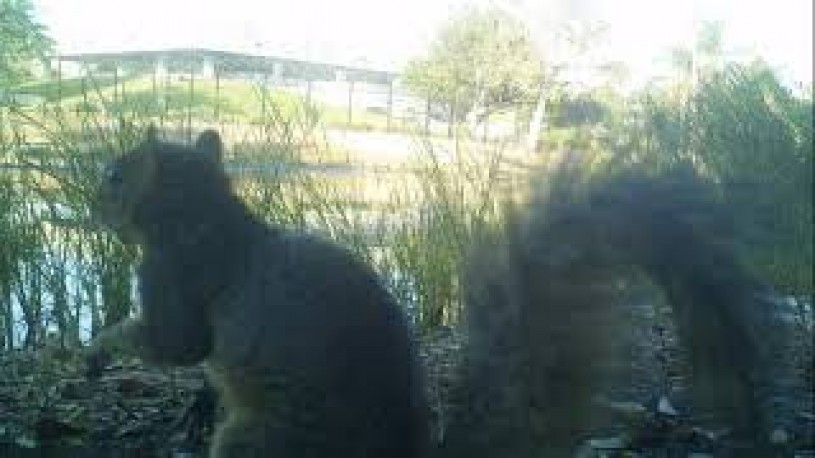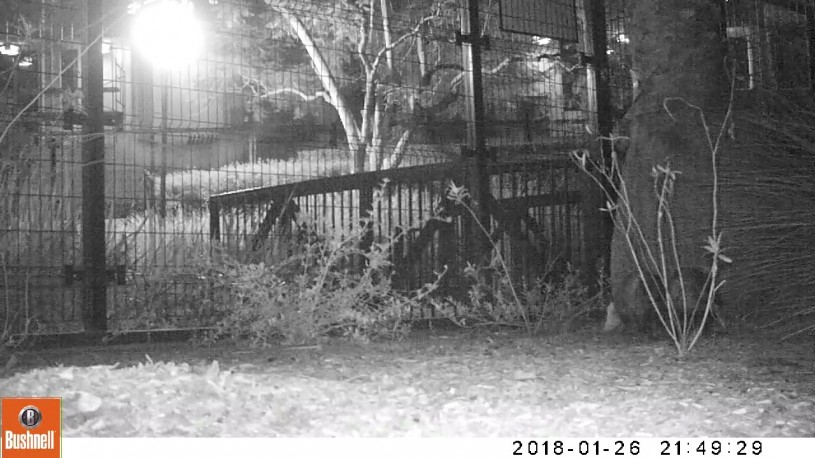BE ADVISED: On Saturday, April 26 and Sunday, April 27, nearby events at Exposition Park and the University of Southern California will impact traffic, parking, and wayfinding in the area. Please consider riding the Metro E (Expo) Line and exiting at USC/Expo station.
Look who didn't get stuck at La Brea Tar Pits
When colleagues at La Brea Tar Pits contacted me, seemingly out of the blue, to request my help with camera trap monitoring in one of their excavation sites, I was already eager to pay them a visit.

When colleagues at La Brea Tar Pits contacted me, seemingly out of the blue, to request my help with camera trap monitoring in one of their excavation sites, I was already eager to pay them a visit. I wanted to see a rare puma skull that was recently excavated from one of the tar pits, so this was another great incentive to visit one of my favorite places. I was caught a little off guard by the request, since camera traps are used to monitor terrestrial wildlife (the kind that still has a pulse) and my colleagues' paleontological research is focused on Ice Age and early Holocene fossils.
It turns out that they were curious about what animals might be visiting their excavation sites after hours.
According to Alexis Mychajliw, a Post Doctoral Fellow at La Brea Tar Pits, "The asphalt seeps at La Brea are still active and recording the changes of our urban landscape. By studying how animals do or don't become entrapped in Hancock Park today, we can actually learn a lot about how entrapment may have happened in the past. Knowing more about the process of entrapment helps us better interpret why some species show up in our data. Plus, it is always nice to see a living mammal after looking at so many fossils!"
Alexis's research is focused on the Holocene epoch, characterized by the point when humans started having a major impact on the global environment, which began about 11,700 years ago and continues to the present day. Her job is to connect the Ice Age ecosystems recorded in La Brea’s fossils with the biodiversity of L.A. today. Therefore, this intersection of studying living mammals and mammal fossils is right up Alexis’s alley.
I walked out to the excavation site and met up with the fossil prep team, who provided me with their local knowledge and an orientation of the site. I had done some exploratory camera trapping and bat acoustic monitoring by the Lake Pit a few years ago but was excited to explore an active excavation site.

Some of the same species that live in Hancock Park today are represented in La Brea Tar Pits Museum's Ice' Age fossil record but other resident wildlife species such as Eastern fox squirrels and Virginia opossums were introduced to L.A. and the western United States by humans relatively recently so they are not found in the Museum's fossil collection.
Here is a compilation of some urban bird and mammal camera trap photos from the Lake Pit taken in 2014:

Warm-blooded animals aren’t the only critters taking advantage of Hancock Park’s unique habitat. Brian Brown, curator of Entomology, recently documented a petroleum fly, a fly that spends its entire larval stage in asphalt feeding on larger insects stuck in the tar, at La Brea Tar Pits.


Two opossums roaming around an excavation site at the La Brea Tar Pits.
What about opossums allow them to easily walk across the liquid asphalt? What gives them (and possibly similar species) an advantage over other species? Is it their creepy dexterous feet or some other aspect of their anatomy, body mass to surface area ratio, physiology, or behavior?
One hypothesis made by the excavation team is that nocturnal mammals like opossums are less vulnerable to getting stuck because the asphalt is less sticky at night due to the fact that the tar hardens during lower nighttime temperatures. If correct, this hypothesis would also explain a bias in the La Brea record towards diurnal mammals active during daylight hours. For example, are there relatively fewer fossil records for raccoons at La Brea because they were uncommon in the area or did their nocturnal behavior give them another advantage?
Further, this can possibly shed light on entrapment patterns during the Ice Age in addition to the present. For example, smaller seeps that are easily hidden (e.g., concealed by leaf litter) and hard during early morning hours could've provided a false sense of security for prehistoric mammals before the same seeps became soupy death traps during the warmer afternoon. Also, migratory species could've been more vulnerable to entrapment when passing through or visiting La Brea during warmer seasons than cooler seasons of the year. What other species living in Hancock Park are regularly getting stuck or tip-toeing across the bubbling tar and at what rate?
Thanks to this surprising footage, researchers studying past and present ecosystems of L.A. will be teaming up to better understand the ecology of pre-historic and present day Hancock Park and La Brea Tar Pits. Stay tuned!

Opossum hind feet have opposable thumbs! Photo: NHMLA Live Animals Program